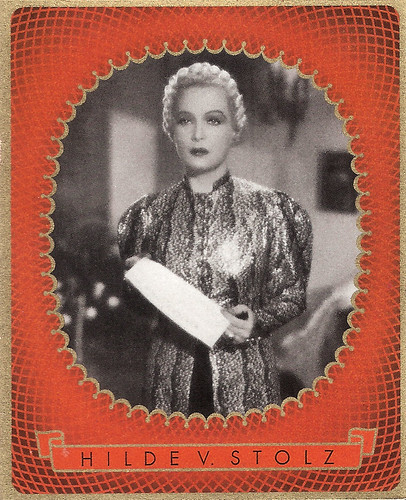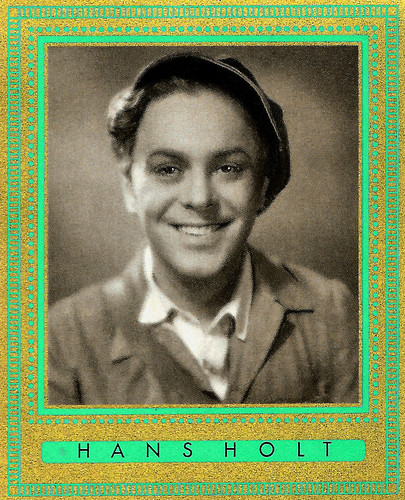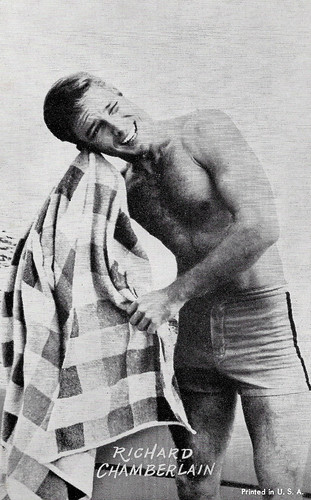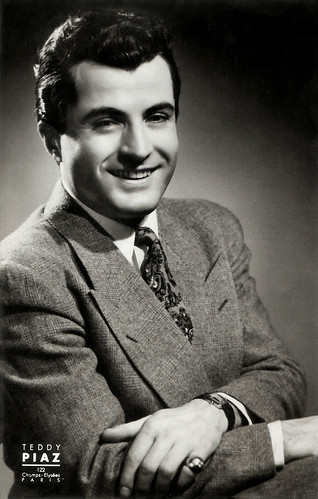
Spanish minicard by Reclam Films, no. 3 of 12. Amleto Novelli as Julius Caesar and Irene Mattalia as Servilia in Cajus Julius Caesar (Enrico Guazzoni, 1914), released in Spain as Julio César. Julius Caesar and Servilia love each other, despite the resistance of her family. They will marry in secret.

Spanish minicard by Reclam Films, no. 11 of 12. Amleto Novelli as Julius Caesar in Julius Caesar in Cajus Julius Caesar (Enrico Guazzoni, 1914), released in Spain as Julio César. Scene: The assassination of Julius Caesar in the Senate.

Spanish minicard by Reclam Films, no. 6 of 12. Amleto Novelli as Julius Caesar and Ruffo Geri as Brutus in Cajus Julius Caesar (Enrico Guazzoni, 1914), released in Spain as Julio César. Brutus watching the assassinated Julius Caesar at the feet of the statue of Pompey in the Senate. He doesn't know yet that he has killed his father.
The influences of Shakespeare
The life and death of Julius Caesar are closely linked to one stage play, William Shakespeare's 'Julius Caesar' (1599. Most of the early films on the emperor, like the Vitagraph production Julius Caesar (J. Stuart Blackton, 1908), the Itala film Giulio Cesare (Giovanni Pastrone, 1909) and the Cines production Bruto / Brutus (Enrico Guazzoni, 1911), follow the plot of the play, even if in a reduced version.
Returning safe and sound from his expeditions, Caesar is flattered by Mark Antony’s plan to crown him emperor. Yet, Brutus, Caesar’s illegitimate son and a stark Republican, abhors this idea. He allies with the Republicans, led by Cassius, to kill Caesar. Despite pleas and warnings by his mistress and a priest, Caesar does go the Senate and is brutally killed there by his son ("Et tu, Brute"). Mark Antony arouses the populace against the killers, who flee the city, followed by an angry mob. At the Battle of Philippi, Caesar’s ghost appears to Brutus, accusing him of the murder. Together with the defeat of his army and Cassius' suicide, this is too much for Brutus, who also commits suicide.
In Italy, Shakespeare’s play was hardly performed in the early twentieth century. A rare performance was given at the Teatro Argentina in Rome on 19 December 1905 by the Compagnia Stabile. While initially praised by the Turin-based daily La Stampa in December 1905, in an article defending the play against its unpopularity in Italy opposite other plays by the Bard. However, in 1906, the same newspaper heavily criticised the staging and the performance of the play, both considered ‘mediocre’. Apart from the performance in Rome in 1905, no staging of 'Julius Caesar' took place in Turin before Itala made its film.
Abroad, there were a few examples to be inspired by. Herbert Beerbohm Tree staged 'Julius Caesar' on 22 January 1898 at the newly-built His Majesty’s at the Haymarket. He played Mark Antony, Charles Fulton was Julius Caesar and Lewis Waller Brutus. While 'Julius Caesar' had been more popular in the early rather than the late 19th century in Britain, Beerbohm Tree’s version was an enormous success, not in the least because of the collaboration of the Anglo-Dutch painter Lawrence Alma-Tadema, who designed the sets and costumes for the play, and was renowned for his well-researched depiction of Roman Antiquity. In 1900, two years after it opened, Tree boasted that already 242.000 people had seen his staging of 'Julius Caesar'.
Another foreign success was the staging of 'Julius Caesar' in Paris, at the Théâtre de l’Odéon, where from 4 December 1906, a translation and re-elaboration of Shakespeare’s play could be seen and heard, with Edmond Duquesne as Caesar, Maxime Desjardins as Brutus, Philippe Garnier as Cassius, and Édouard de Max as Mark Antony. Lucien Jusseaume had designed the sets, while music by Gustave Doret was added, conducted by Émile Bretonneau. The play was well publicised, including by a large set of postcards, showing the various acts of the play - a common use for the Parisian stage by the early 1900s.

British postcard by Rotary Photo, E.C., 105 K. Photo: Lizzie Caswall Smith. Johnston Forbes-Robertson as Julius Caesar in George Bernard Shaw's play 'Caesar and Cleopatra' (1899).

Russian postcard. Vasily Kachalov as Julius Caesar and Alexander Vishnevsky as Mark Antony in Shakespeare's play 'Julius Caesar', staged in 1903 at the Moscow Art Theater and directed by Vladimir Nemirovich-Danchenko.

British postcard in the Wrench Series, no. 997. Photo: Biograph Studio, mailed 1902. Lewis Waller as Brutus in the play 'Julius Caesar' by William Shakespeare, a role which he first performed in 1898 at the Haymarket Theatre, opposite Herbert Beerbohm Tree as Mark Antony.

British postcard by Rotary Photo E.C. 106R. Photo: Burford. Herbert Beerbohm Tree as Mark Antony in William Shakespeare's play 'Antony and Cleopatra'. In 1906, Beerbohm Tree's extravagant revival of 'Antony and Cleopatra' opened at His Majesty's Theatre, with Tree as Mark Antony and Constance Collier as Cleopatra. Tree already had played Mark Antony in a version of Shakespeare's play 'Julius Caesar', first performed in 1898 at Her Majesty's Theatre, with Tree as Mark Anthony, Lewis Waller as Brutus, Charles Fulton as Caesar, Evelyn Millard as Portia (Brutus' wife), and Lily Hanbury as Calpurnia (Caesar's wife).

French postcard by Collection Photo-Programme, Paris. 'Jules César' (Julius Caesar) by William Shakespeare, performed at the Théâtre de l'Odéon in Paris. First night at 4-12-1906. Translated and reworking of Shakespeare by Louis de Gramont. 6th Tableau. The Senate. Julius Caesar listens to the supplications by Cassius, and Brutus.... Edmond Duquesne played Caesar, Maxime Desjardins Brutus, Philippe Garnier Cassius, Édouard de Max Mark Antony, Ballot Pindarus, and Madeleine Barjac Calpurnia. Scenes by Lucien Jusseaume, and music by Gustave Doret.

French postcard in the Nos artistes dans leur loge series, no. 133. Photo: Comoedia. Maxime Desjardins.
Pictorial appropriations
It is worthwhile to investigate Giovanni Pastrone's pictorial appropriations in Giulio Cesare (Itala, 1909). The assassination of Caesar in the Senate is a key moment in the film. The violent act and the frenzy of the killers were already well expressed in a painting quite close to the moment in the film, namely in 'La Curée / L'assassinat de César' (1887, Grenoble, Musée des Beaux-Arts) by Georges-Antoine Rochegrosse. Yet, the background in Rochegrosse’s canvas is much vaster in its dimensions and ambitions.
While considering the depiction of Caesar’s death in 19th-century painting, one of the most famous examples is Jean-Léon Gérôme’s 'Mort de César / Death of Caesar' (1867, Walters Art Museum, Baltimore). Yet, this painting rather shows the moment after, when the assassinating senators leave the Senate and the corpse of Caesar, the face covered, is left beneath the statue of Pompey. The space is covered in darkness, with light on the killers, seen on he back, denying us their emotions. It is exactly this painting, proliferating through endless reproductions, that would be used as a citation in the American film Julius Caesar (J. Stuart Blackton, 1908), produced by The Vitagraph Co. of America one year before the Itala production. Two years after the Itala film, Enrico Guazzoni would cite the painting again in his short film Bruto / Brutus (Cines, 1911), which also closely follows the Shakespeare play, and also quotes a painting, Prospero Piatti's 'I funerali di Cesare' (1898, Museo Nacional de las Bellas Artes, Santiago de Chile).
In 1914, Enrico Guazzoni was strengthened by the experience of the direction of his recent feature-length epics Quo vadis? (1913) and Marcantonio e Cleopatra (1913). He asked Raffaele Giovagnoli, author of the novels 'Spartaco' (1874) and 'Messalina' (1885), to write a script that mixed Shakespeare's play with Ancient sources such as Plutarchus' 'Vitae' and Caesar's own 'Comments' into a vast enterprise with enormous sets and countless extras. The film starts with the secret affair between a young Caesar and the pretty Servilia, who yet belongs to the austere patrician family of Cato, who forbid the affair. The couple secretly marries, and after Caesar's flight because of dictator Sulla, Servilia is forced to marry Brutus Sr., to whom she has to confess on her wedding night that she is pregnant with Caesar's child. The child will not know who is real father is.
Years after, Caesar gloriously returns after the Civil War is over and becomes a powerful army general, leading the wars in Gaul and conquering Vercingetorix. Yet, the senators started to fear his power and wealth. The plot then follows the Shakespearean play with the attempts to crown Caesar emperor, the warnings in vain, the assassination in the Senate, and Mark Antony's call to the people to take revenge on the assassins, while Servilia tells Brutus he has killed his father. The surviving print lacks an episode with Cleopatra, played by Pina Menichelli, while Amleto Novelli, the hero of Guazzoni's previous epics, once more played the lead. The existing film print, despite its great tinting and toning colouring, unfortunately suffers from an overabundance of intertitles, while only in the assassination scene, just like in the arena scene in Quo Vadis?, we encounter a rare moment of analytical editing instead of a tableau-style kind of filming (one shot one set).
In the sound era, the life and death of Julius Caesar was depicted in films on the relationship between Caesar and Cleopatra such as Cleopatra (Cecil B. DeMille, 1934), Caesar and Cleopatra (Gabriel Pascal, 1945), Carry On, Cleo (Gerald Thomas, 1964), and the various Asterix-films, while more related to the Shakespeare play was Julius Caesar (Joseph Mankiewicz, 1953) starring Louis Calhern as Julius Caesar, Marlon Brando as Mark Anthony and James Mason as Brutus. Several other Shakespeare adaptations followed, such as the 1969/1970 version by Stuart Burge, with Charlton Heston, Jason Robards and John Gielgud as Mark Antony, Brutus and Caesar. A remarkable variation was Cesare deve morire / Caesar Must Die (2012) by Paolo and Vittorio Taviani, in which the real inmates of the Rebibbia prison in Rome stage the Shakespearian play. The film won the Golden Bear in Berlin.

British postcard by Film Weekly. Photo: Paramount. Warren William as Julius Caesar and Claudette Colbert as Cleopatra in Cleopatra (Cecil B. DeMille, 1934).

Dutch postcard by HEMO. Photo: Eagle Lion. Claude Rains in Caesar and Cleopatra (Gabriel Pascal, 1945).

Italian postcard by Rotalfoto, Milano, no. 555. Photo: Metro-Goldwyn-Mayer. Marlon Brando as Mark Antony in Julius Caesar (Joseph L. Mankiewicz, 1953). .
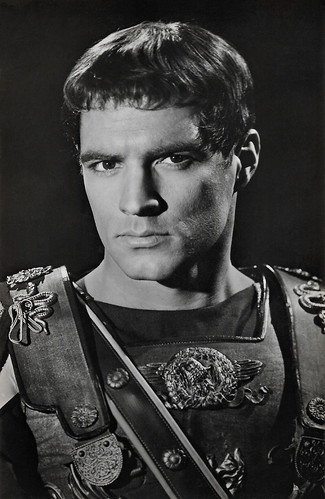
Spanish postcard by Archivo Bermejo, no. 7142. Photo: Universal International. John Gavin as Julius Caesar in Spartacus (Stanley Kubrick, 1960).

East-German postcard by VEB Progress Film-Vertrieb, Berlin, no. 2655. Kenneth Williams as Julius Caesar and Amanda Barrie as Cleopatra in Carry On Cleo (Gerald Thomas, 1964), released in the GDR as Cleo, Liebe und Antike. It was the tenth in the series of the 31 Carry On films, produced by Peter Rogers and distributed by Anglo-Amalgamated.
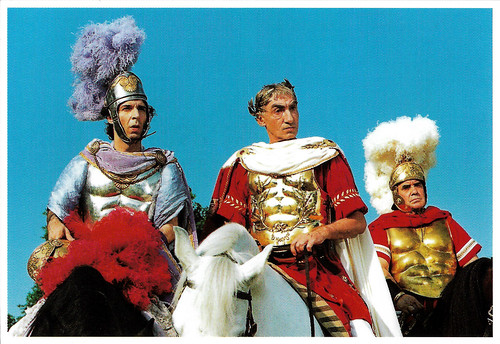
Small French postcard by McCann Communications, Nanterre, offered by AGFA. Photo: Etienne George / Renn Productions. Roberto Benigni, Gottfried John as Julius Caesar and Jean-Pierre Castaldi in Astérix & Obélix contre César/Asterix and Obelix vs Caesar (Claude Zidi, 1999).
Sources: Ivo Blom (Quo vadis. Cabiria and the 'Archaeologists', 2003), research project Museum of Dream Worlds, Wikipedia (English and Italian), and IMDb.












